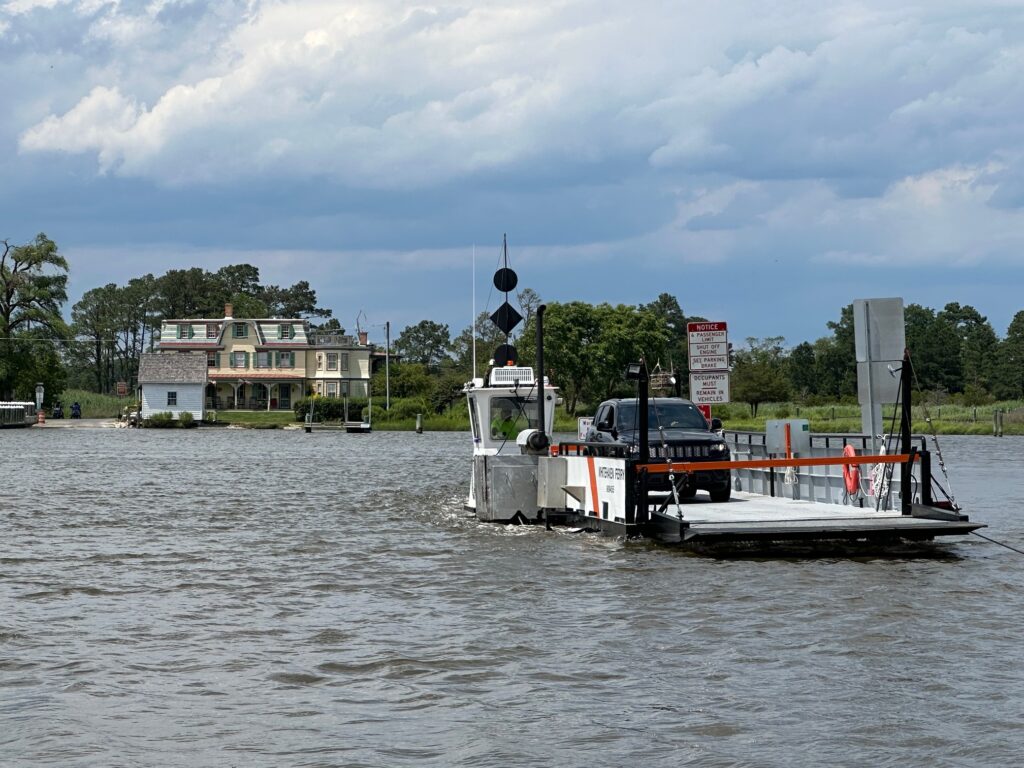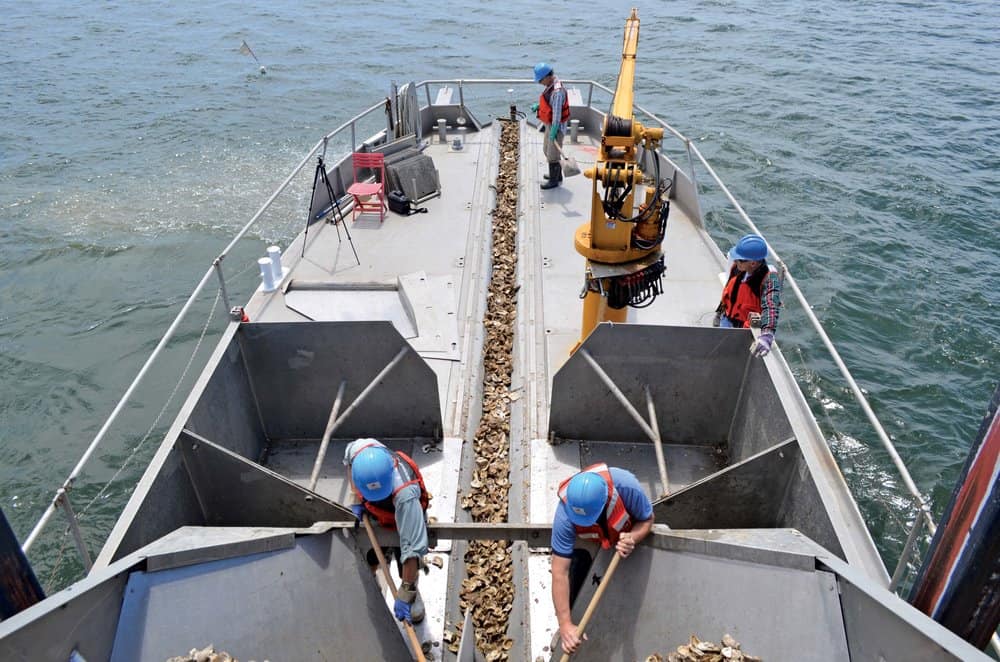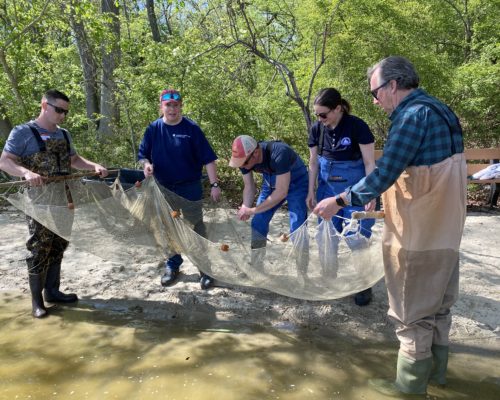When you consider the Chesapeake Bay is fed by more than 150 streams and rivers and has 11,684 miles of shoreline, there’s a lot of places from which to see the other side of the water. Getting to the other side usually requires a boat or a long car trip “up and around.” As many people winterize or pull their boats for the winter, there’s another option to consider: an old-fashioned ferry ride.
If you’re looking for a fun way to experience the waterfront in the off-season, take a road trip using one of these Chesapeake Bay ferry crossings, each with its own rich story.
The Whitehaven Ferry
In the 1600s, Whitehaven, Maryland, was a go-to location for ships to pick up and unload supplies and travelers because it was just a few miles inland from the Chesapeake Bay, on the Wicomico River. With all the activity on one side of the river, there was a need to get these essentials to the other side, even though it was just 1,200 feet away. Around 1692, it was decided a pair of ferries were needed at no cost to farmers and travelers. Wooden tugs and barges were built at Whitehaven during World War 1. Today, both the Whitehaven and Upper ferries are still free. It is one of the country’s oldest, if not the oldest, ferry systems in the country.
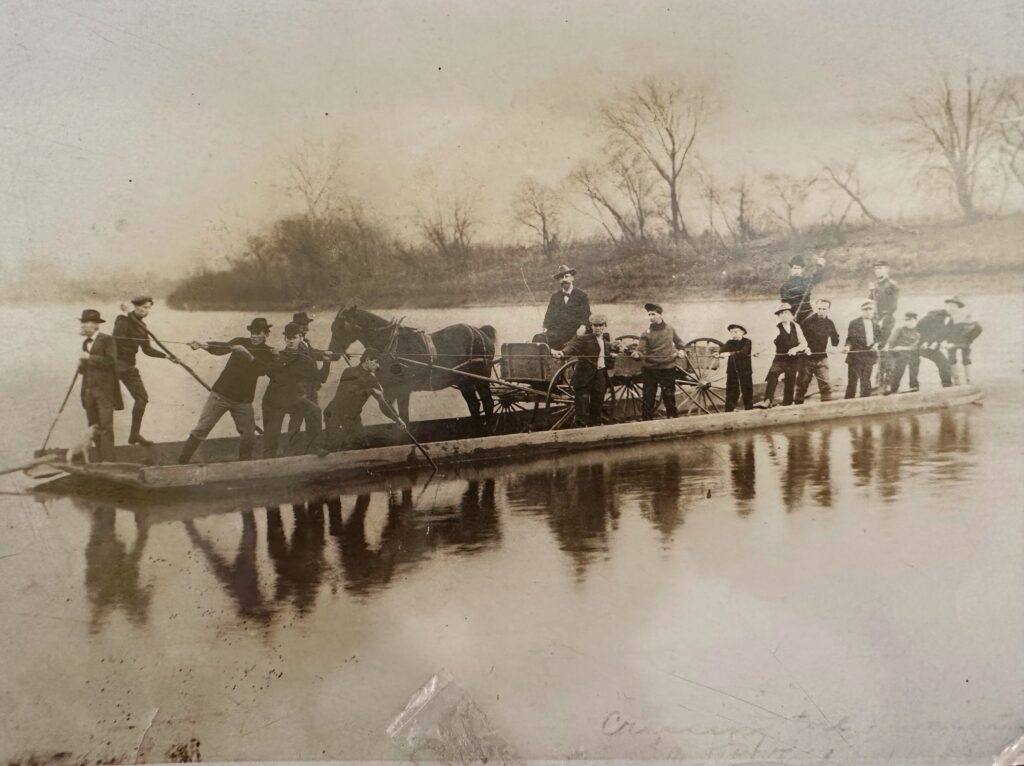
“Back then, a line was tied across the Wicomico River between the Whitehaven shoreline and the opposite shore, and wooden barges would be pushed from one side to the other with long poles,” says Nancy Robertson of the Whitehaven Heritage Association. “Horses and buggies were common passengers.”
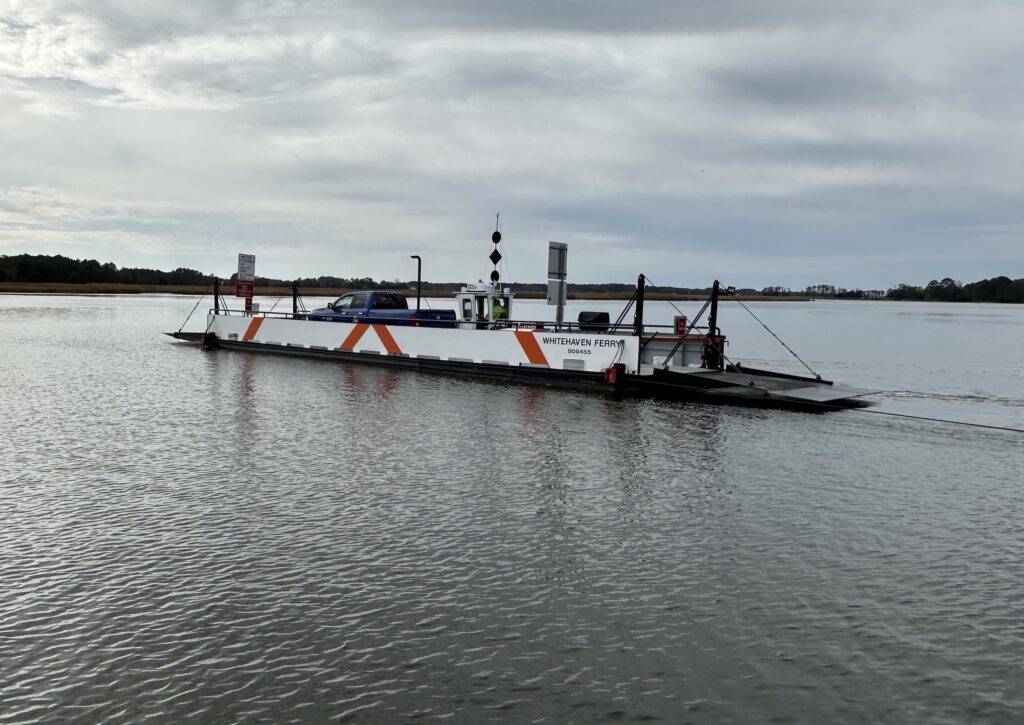
Today, the “line” still exists but as an underwater cable. The operators are always in contact with any tugs pulling barges on the river and will delay a crossing in order to ensure the cable doesn’t get tangled in a tugboat’s propeller or rudder. Recreational boaters are advised to avoid the ferries as they cross when making a trip up or down the Wicomico.
Located off Nanticoke Road (MD 349) the Upper Ferry exit takes drivers and bike riders through farmland to the ferry landing. It’s a shorter distance (about 300 feet) and takes about 90 seconds to get to the Wicomico crossing. This is a more direct route to Princess Anne (10 miles by ferry vs. 19 by car) and is busier than the Whitehaven Ferry.
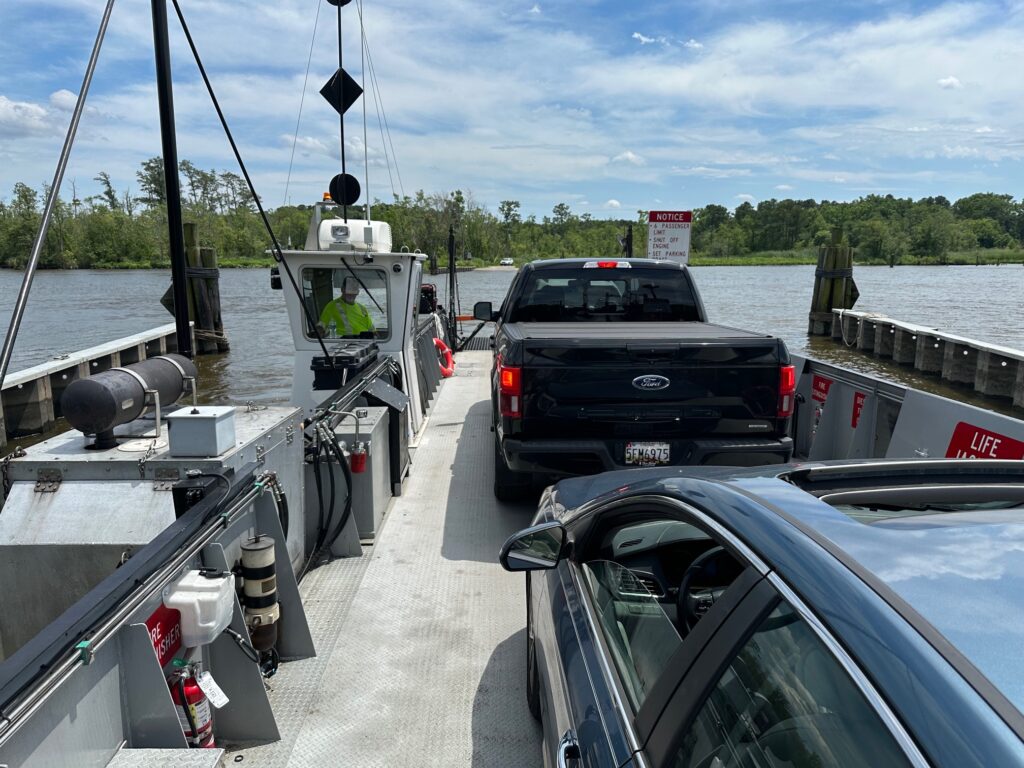
“We can only take three cars with a total of six passengers,” notes Whitehaven Ferry operator Brian Dize, “and I get a lot of questions about history.” A common topic is the classic, Victorian-style 1877 Whitehaven Hotel next to the ferry dock that offered lodging for steamboat passengers taking a break on their travels. Nearby was a tomato canning factory as well as stores and a school. Today, the renovated hotel is a popular B&B.
Innkeeper and General Manager Cindy Curran says that the ferry is a big draw for tourists. “In the 23 years I’ve been running the hotel, many of our guests are intrigued by the ferry and make it a day trip or a quick trip just to take the ferry across the river,” she says. “’What’s on the other side?’ is the common question and I’m happy to tell them about the points south of the town of Princess Anne, where they can find small antique shops, the Bordeleau winery as well as a small historic town.”
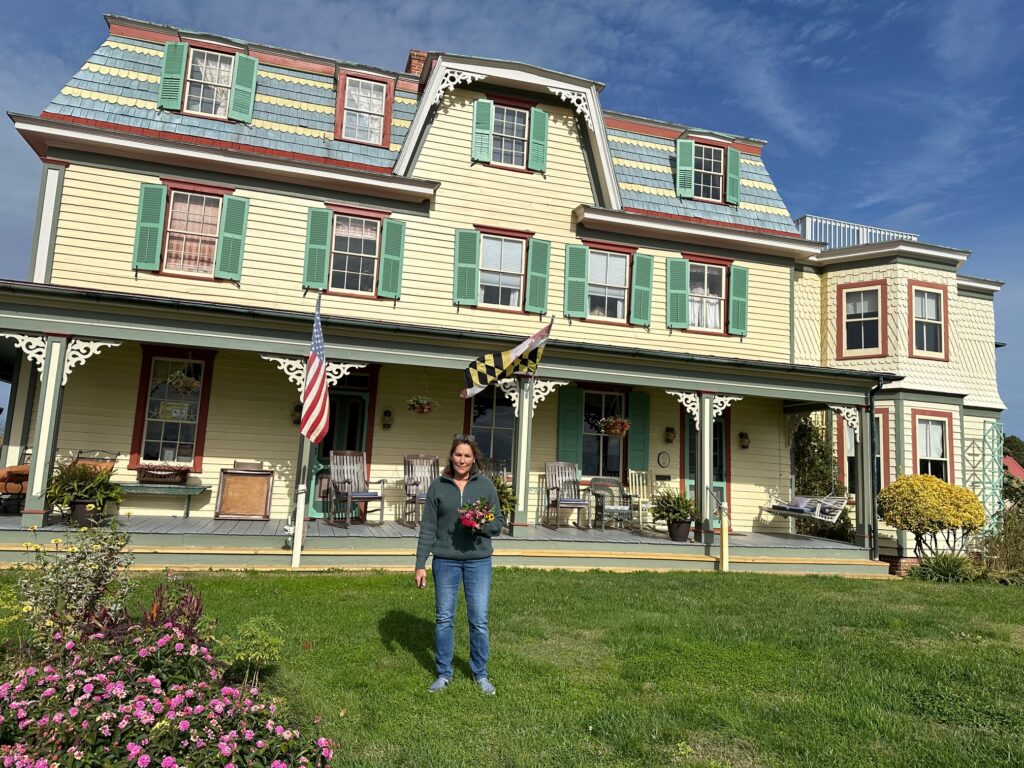
Curran calls the ferry a “great treasure of Maryland history” and praises its captains’ friendliness and patience.
“If there’s a dog in the car, I always have a bone for chewing,” says ferry driver Alan Lambert, “and of course there’s a lollipop for the kids.”
Both ferries operate for shorter hours during the winter but are available year-round, except holidays.
Oxford Bellevue Ferry
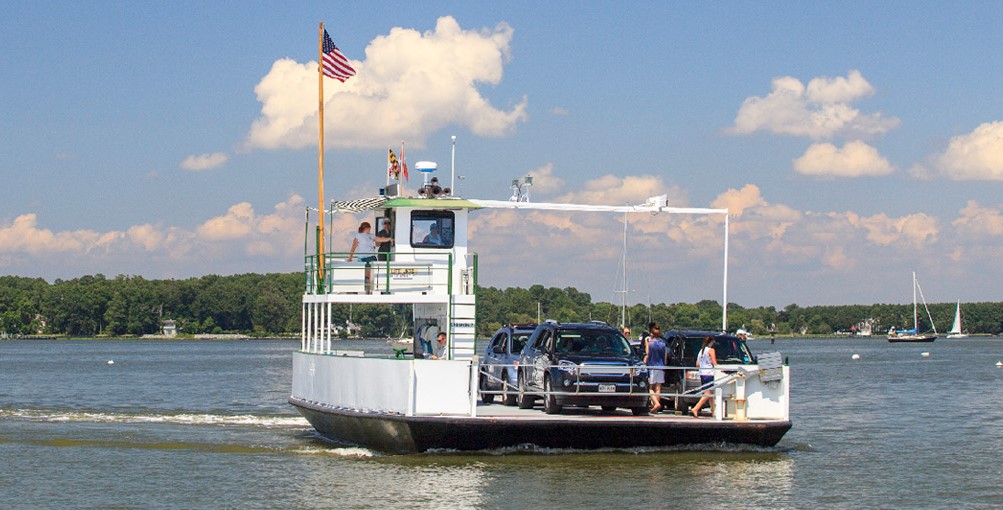
It’s the oldest privately-owned ferry service in the country. In 1683, Talbot County, Maryland officials needed a way to bring horses and farm supplies across the ¾-mile Tred Avon River. On one side, Bellevue was home to seafood packing plants and across the river, Oxford was one of two ports of entry for ships in the state (Annapolis was the other). The ferry job consisted of rowing a large wooden scow between the shorelines and the pay was 2,500 pounds of tobacco. Incredibly, more than 340 years later, the ferry is a 65’ vessel moving nine cars and multiple passengers at a time each way. It’s seasonal, moving to weekends only in November and shutting down from late November through March.
“People may think it’s boring just going back and forth but I can tell you it’s always changing,” says Judy Bixler who, with her husband Tom, owns the ferry. “Two trips are never the same.”
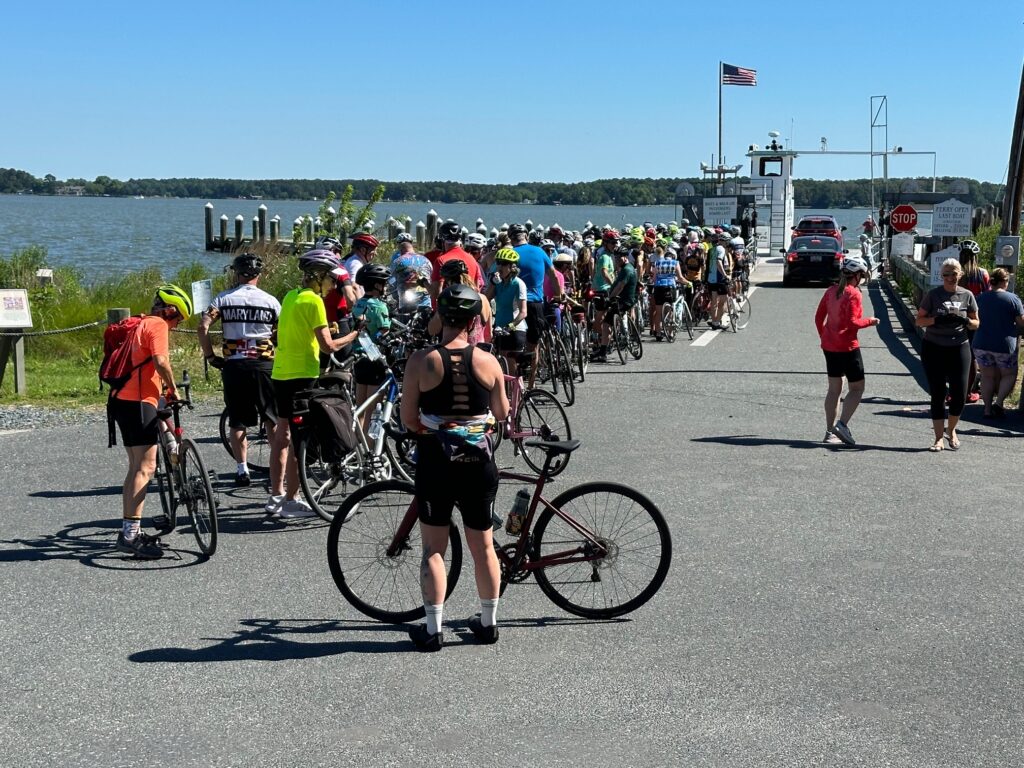
For example: in early June this year, the annual Tour de Talbot 100-kilometer bike ride brought hundreds of bicyclists to the ferry, crossing from Oxford to Bellevue. That event went on for hours, although, when needed, room was made for a car or two. Speaking of making room, in 2004, a group of Mini Cooper drivers were able to fit 18 of the small cars on the boat for a crossing. And then there’s the list of notable people who make the trip:
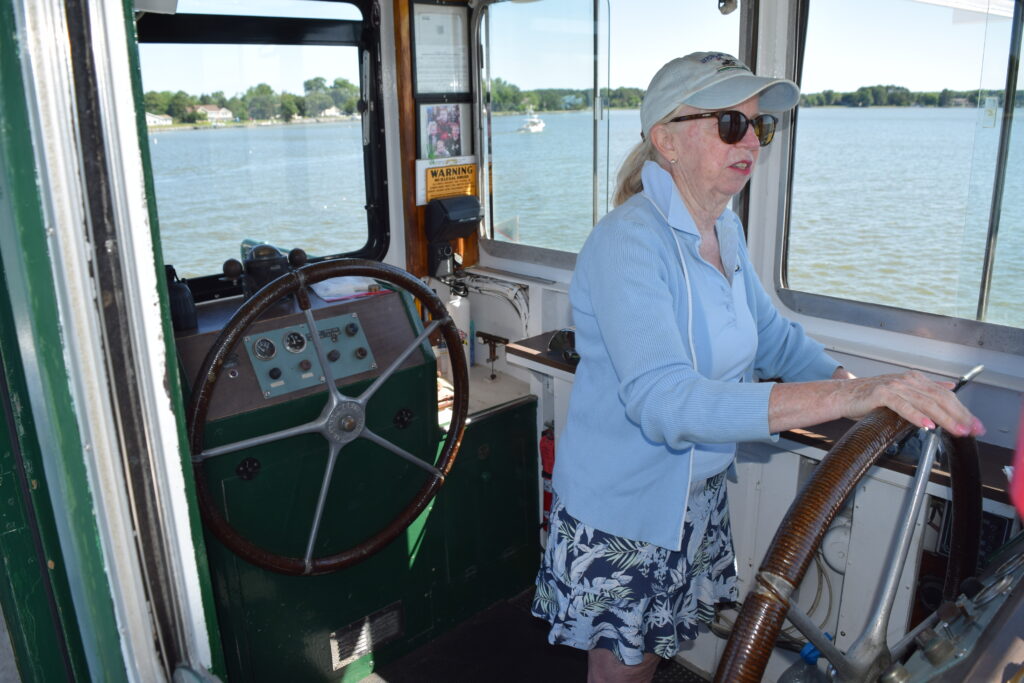
“When Vice President Cheney lived in the area, he used to ride the ferry quite often with the Secret Service. One time, we had to leave Defense Secretary Donald Rumsfeld on the Bellevue side because there wasn’t room to get his car aboard. His grandchildren jumped onto the boat and rode the ferry to Oxford and then back again. He and Mrs. Cheney were lovely folks. And Mr. Rumsfeld was patient, for sure,” recalls Bixler.
Many use the ferry while visiting nearby St. Michaels or Tilghman Island to tour Oxford where the ferry docks. A few hundred feet away is the Robert Morris Inn, which opened around 1710, and is where James Michener wrote the outline of his bestseller Chesapeake in 1978. The inn is still welcoming guests while the restaurant undergoes renovations for a new chef team. In the meantime, they’re offering a delicious-sounding Thanksgiving buffet.
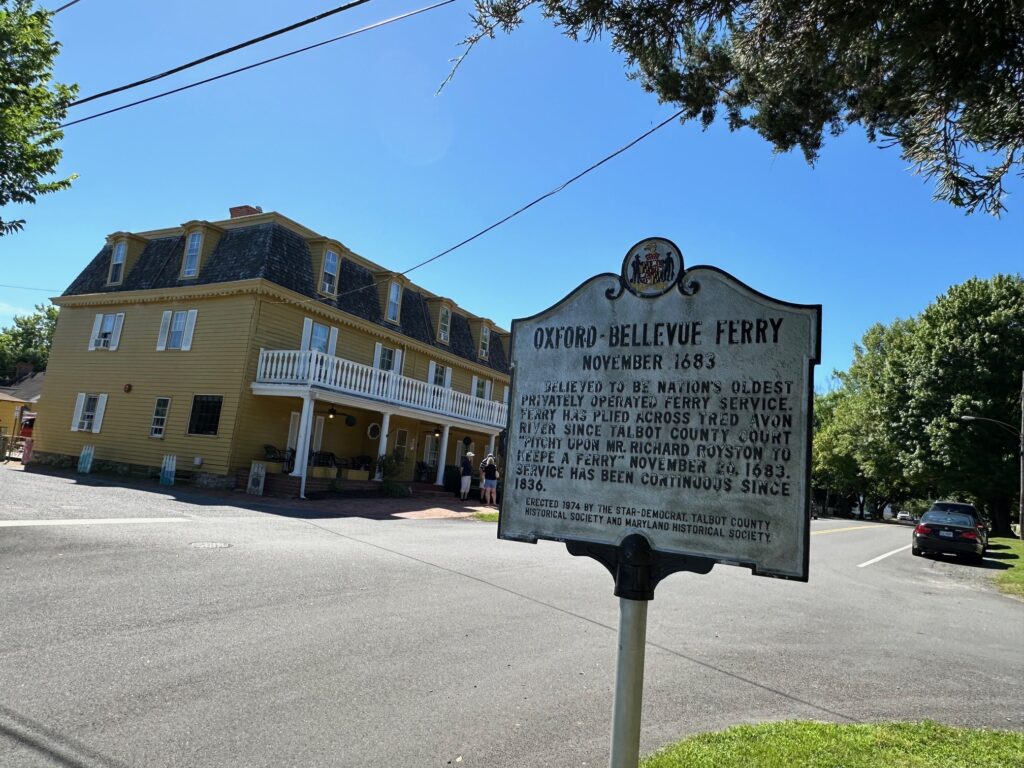
Around the time the Robert Morris Inn opened in the early 1700’s, Judith Bennett was an innkeeper and also operated the ferry service. She had three husbands who assisted her during their marriages, but when she was “between spouses”, she also ran the ferry for ten years.
In the present day, Judy and Tom Bixler have owned and operated the Oxford Bellevue ferry for 23 years. Now in their 70s and looking to spend more time with their grandchildren, the couple is searching for the next generation of ferry operators. The ferry business is for sale, but the Bixlers say they’ll wait for just the right fit.
Island Ferries Based in Crisfield
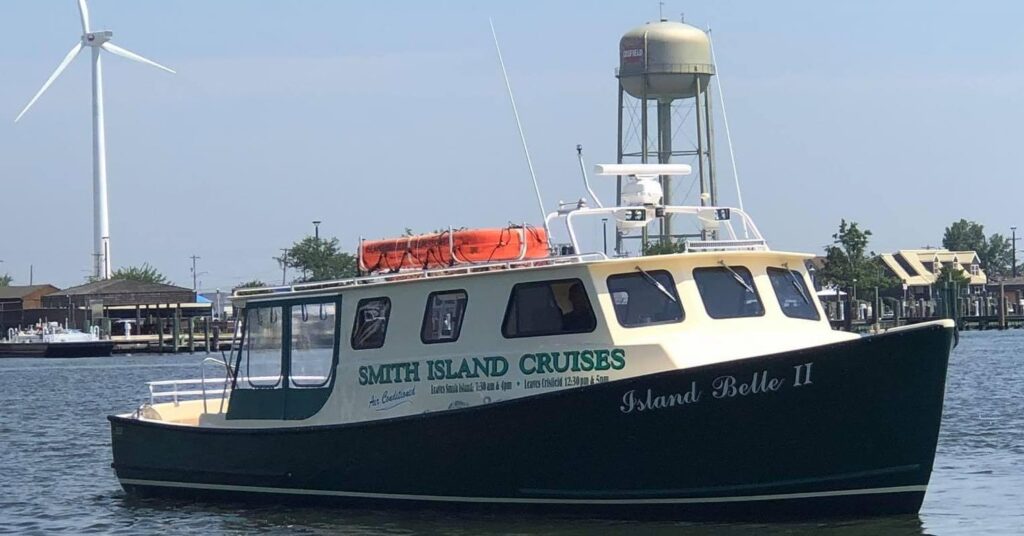
For the Eastern Shore islands of Smith and Tangier, ferries aren’t just a convenience, but a necessity. From Crisfield, visitors can visit these special islands only by water.
The West Main Street dock in the Crab Capital of the World, also known as Crisfield, Maryland, gets busy around 12:30 p.m. That’s when ferry boats leave with passengers, cargo, and mail to nearby islands offshore. There are generations’ worth of family history on the two ferries involved in the job.
Smith Island
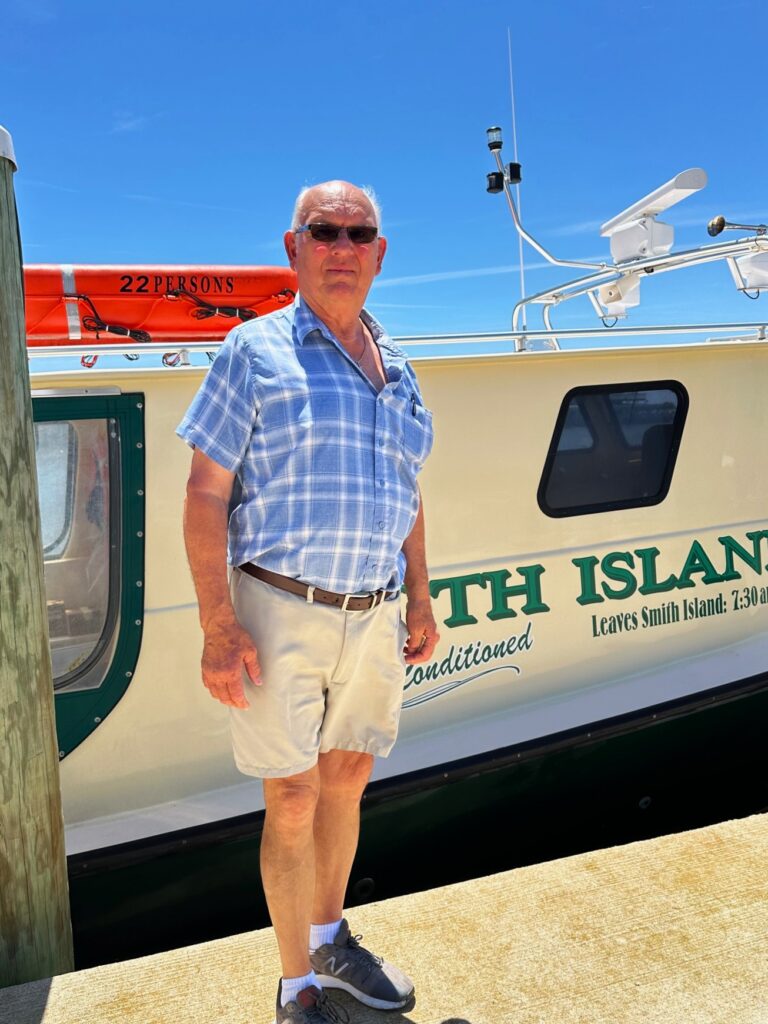
Captain Otis Tyler operates Island Belle II and probably knows the 12-mile course to Smith Island better than anyone. His family has been making the trip for four generations.
“I carry FedEx, UPS, groceries, and personal freight for individuals on the island. I’ve delivered building materials, refrigerators, a stove; anything they need,” he says from his Smith Island home.
Sometimes high winds put a stop to mail (and passenger) delivery. “If the weather conditions aren’t favorable, it’s my decision not to go. Usually that means if the winds are 35 mph or more with temperatures below freezing. Any water splashing on the windshield becomes a layer of ice and that’s dangerous. There’s been a couple of times, even this past winter, where I’ve had to cancel the trip.”
Smith Island ER
Tyler did break his weather rule once, for a life-or-death situation. On February 6, 2010, a Smith Island resident had a bad fall in her home and needed medical care. Outside, the blizzard conditions brought heavy snow with 50 mph winds. Ferry operator and Fire Chief Tyler took the call requesting emergency assistance. He called the 911 Operations Center in Princess Anne and was told the weather was too dangerous for a Medivac helicopter to get to Smith Island. He remembers the words from the U.S. Coast Guard, saying that the mailboat was the only way to assist.
He would “have to undertake a dangerous trip of the Chesapeake Bay under extreme conditions.” As captain of the mailboat Island Belle, Tyler made the decision to go, bringing assistance on board including his assistant fire chief, who was also a preacher. They said a prayer just before the ferry left Smith Island for Crisfield. “It was like a calm came over the boat,” Tyler recalls. Battling water from the high waves freezing on the wind shield, Island Belle arrived in Crisfield where an ambulance was waiting. The patient healed from her wounds and lived for another few months.
Another Smith Island-bound ferry is the Smith Island Cruises vessel Chelsea Lane Tyler, takes passengers to Smith from about May 15 to October 15. Smith Island Cruises also runs a ferry from Reedville, Virginia, to Smith Island.
If you haven’t been to Smith Island recently (or ever), it has an ever-growing list of experiences for visitors looking to experience island culture. Get inspired to plan your trip here.
Tangier Island
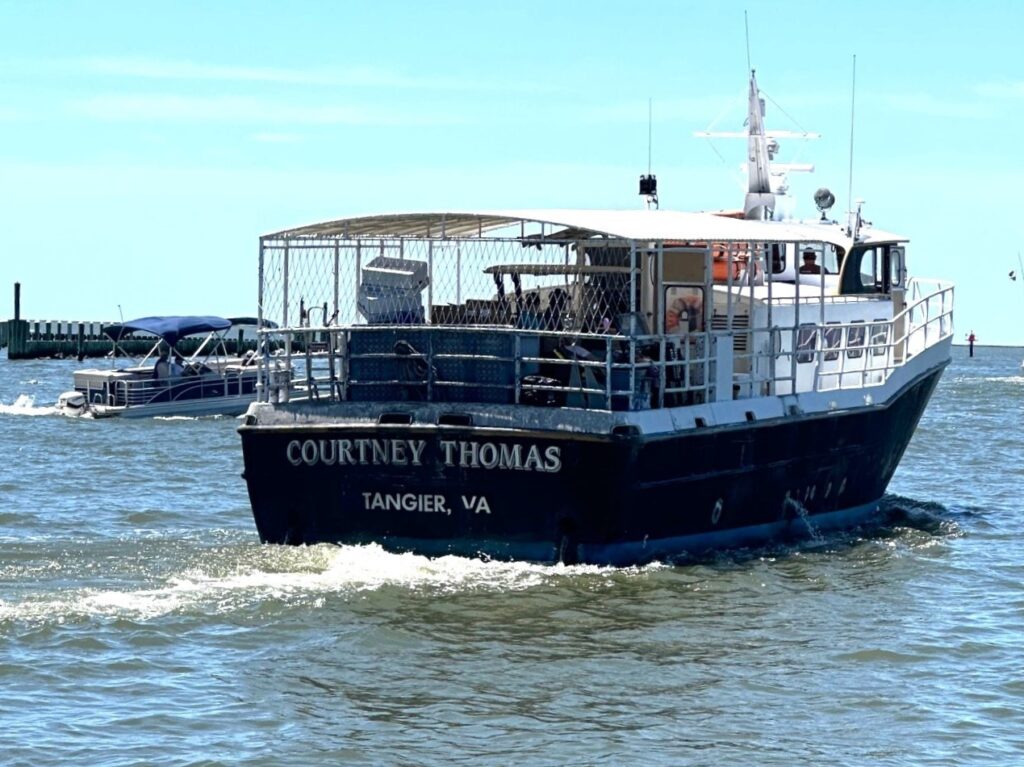
Also leaving the Crisfield dock is the Courtney Thomas, carrying both mail and passengers to Tangier Island 13 miles offshore. Brett Thomas, fifth generation of the Thomas family, is at the helm. Much more than a mailboat, the Courtney Thomas is an important public service. The Thomases’ long family legacy is “something I think about,” says Brett’s mother Beth Thomas, whose late husband Rudy Jr. first captained the 65-foot island boat, “especially today, when family businesses seem to be going away.”
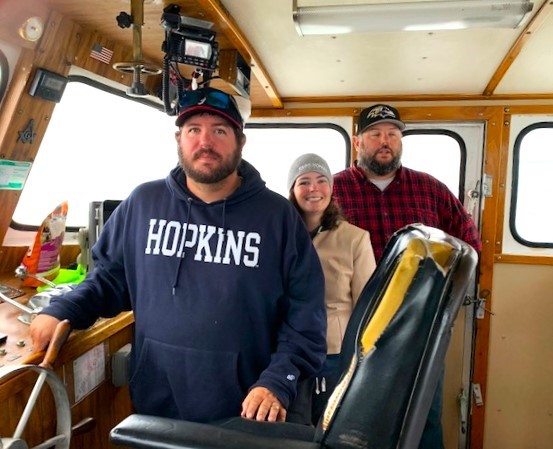
That makes it all the more impressive that this family operation has been going strong since Brett’s great-great grandfather, John W. Thomas, began running a ferry around 1904. The current vessel is named for Beth’s daughter, Courtney Thomas. Courtney’s brother, Steven, operates a seasonal passenger ferry out of Crisfield, the Steven Thomas.
Know Before You Go
If you plan a Crisfield departure on a ferry to Smith or Tangier, there’s a simple reason everyone leaves at 12:30.
“It’s so that the time is consistent regardless of how many boats and captains will be heading out for the day,” says a spokesman for the Crisfield Chamber of Commerce. “This schedule is well known and used by many to move back and forth from Smith Island and Crisfield on a daily basis.” About 5,000 people every year take a ride on a Crisfield ferry. If you miss the ferry, you’d better have a friend with a boat.
Another ferry worthy of mention: the Scotland Ferry, which takes you to Surrey, James River’s hidden gem. It’s a 20-minute ride on the VDOT-operated public ferry from Virginia’s Historic Triangle (Jamestown, Yorktown and Williamsburg). Our John Page Williams details the hidden gem that lies on the other side of the river with history all its own.
Hundreds of years after the Bay’s first ferries began, they are still a practical fixture on the Bay, for those times when you don’t have a boat handy to get to the other side of the water. They’re also a special piece of history—a ride into the past–and there’s a ferry tale within every trip.

